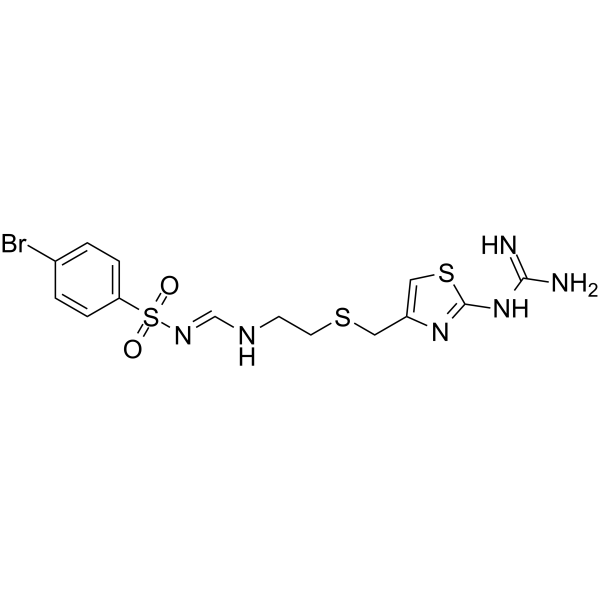
Ebrotidine
CAS No. 100981-43-9
Ebrotidine ( FI3542 )
Catalog No. M26675 CAS No. 100981-43-9
Ebrotidine is a competitive H2-receptor antagonist with Ki of 127.5 nM. Ebrotidine has a potent antisecretory activity and evidenced gastroprotection.
Purity : >98% (HPLC)
 COA
COA
 Datasheet
Datasheet
 HNMR
HNMR
 HPLC
HPLC
 MSDS
MSDS
 Handing Instructions
Handing Instructions
| Size | Price / USD | Stock | Quantity |
| 2MG | 33 | Get Quote |


|
| 5MG | 53 | Get Quote |


|
| 10MG | 87 | Get Quote |


|
| 100MG | Get Quote | Get Quote |


|
| 200MG | Get Quote | Get Quote |


|
| 500MG | Get Quote | Get Quote |


|
| 1G | Get Quote | Get Quote |


|
Biological Information
-
Product NameEbrotidine
-
NoteResearch use only, not for human use.
-
Brief DescriptionEbrotidine is a competitive H2-receptor antagonist with Ki of 127.5 nM. Ebrotidine has a potent antisecretory activity and evidenced gastroprotection.
-
DescriptionEbrotidine is a competitive H2-receptor antagonist with Ki of 127.5 nM. Ebrotidine has a potent antisecretory activity and evidenced gastroprotection.(In Vitro):Ebrotidine displaced 3H-thiotidine specific binding to histamine H2-receptors, showing a higher affinity than ranitidine (Ki = 190.0 nM) and cimetidine (Ki = 246.1 nM) .(In Vivo):Ebrotidine inhibited histamine- (ED50: 0.21 mg/kg) and pentagastrin- (ED50: 0.44 mg/kg) stimulated acid secretion in a dose-dependent manner in rats . Ebrotidine at doses of 50mg and higher/kg body weight effectively prevented mucosal injury, and that the maximal protective effect was achieved by 1h. Ebrotidine evoked 30% increase in mucus gel dimension, and showed 20% increase in phospholipids, and the content of sulfo- (18%) and sialomucins (21%) . The mean number of gastric erosions seen at endoscopy after treatment with Ebrotidine plus ASA (2.0 +/- 0.3) was obviously lower than that after placebo plus ASA (3.7 +/- 0.2). This reduction in lesion core by Ebrotidine was accompanied by a significant increase in gastric blood flow (by 15% in corpus and 26% in antrum), by a rise in transmucosal potential difference (by 12%), and by a decrease of mucosal microbleeding.
-
SynonymsFI3542
-
PathwayGPCR/G Protein
-
TargetHistamine Receptor
-
RecptorHuman Endogenous Metabolite; Nucleoside Antimetabolite/Analog
-
Research Area——
-
Indication——
Chemical Information
-
CAS Number100981-43-9
-
Formula Weight477.4
-
Molecular FormulaC14H17BrN6O2S3
-
Purity>98% (HPLC)
-
Solubility——
-
SMILESNC(=N)Nc1nc(CSCCN\C=N\S(=O)(=O)c2ccc(Br)cc2)cs1
-
Chemical Name——
Shipping & Storage Information
-
Storage(-20℃)
-
ShippingWith Ice Pack
-
Stability≥ 2 years
Reference


-
Pitolisant oxalate
A potent and selective antagonist of H3 receptor with Ki/EC50 of 0.16/1.5 nM; no effect on H1, H2, H4 receptors (IC50>10 uM).
-
JNJ-5207852 dihydroc...
JNJ-5207852 is a novel, non-imidazole histamine H3 receptor antagonist, with high affinity at the rat (pKi=8.9) and human (pKi=9.24) H3 receptor. JNJ-5207852 is a potent dibasic amine antagonist that binds potently to rat H3 receptors (Ki=1.2?nm), and has good brain penetration. In ex vivo binding studies in mice, the compound had an ED50 of 0.13?mg?kg?1, subcutaneously.
-
Sodium butanoate
Sodium Butyrate(Butanoic acid sodium salt) has been reported to cause hyperacetylation of histones due to its role as a histone deacetylase (HDAC) inhibitor (IC50 values are 0.3, 0.4, 0.3, mM for HDAC1, 2 and 7 respectively).



 Cart
Cart
 sales@molnova.com
sales@molnova.com


